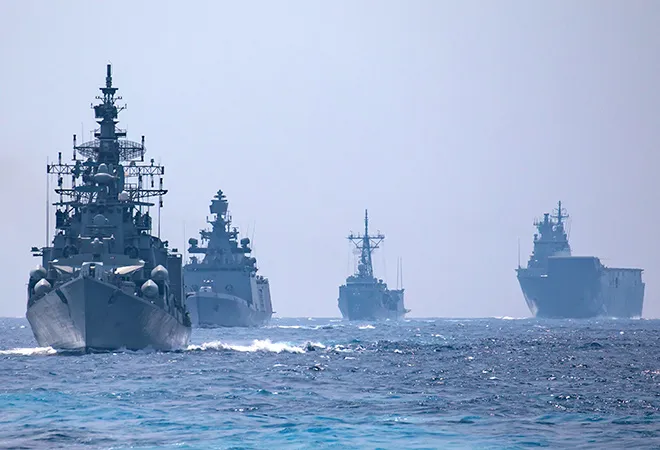-
CENTRES
Progammes & Centres
Location
India and Australia must raise the level of their engagement, going beyond pre-planned exercises and sporadic deployments

This piece is part of the series, India–Australia Partnership: The Defence Dimension
Australia-India relations have been on the upswing lately. As comprehensive strategic partners since June 2020, New Delhi and Canberra have positioned defence cooperation as a key pillar of the bilateral partnership, particularly in the maritime domain. But this now needs to progress to a more sustained engagement across a variety of maritime agencies.
Last month, Australia’s Defence Strategic Review (DSR) called for an expansion in the relationship with India. Canberra’s announcement earlier this year, that the forthcoming Malabar naval exercise will be held off Australia for the first time, signals more convergence between Quad partners. The Indian Navy will be sending warships and P-8I long-range maritime patrol aircraft to the exercises.
For many, conducting Exercise Malabar in Australia’s waters is a natural progression. They have been held off the coast of India and Japan since October 2020, when Australia rejoined the exercises after many years. Indian observers acknowledge this is, to a significant degree, an outcome of Canberra’s determined push to be a more active maritime partner with India.
Canberra’s announcement earlier this year, that the forthcoming Malabar naval exercise will be held off Australia for the first time, signals more convergence between Quad partners.
It is encouraging for New Delhi that the Royal Australian Navy (RAN) has been sending sizable maritime contingents to the Indian Ocean. Although RAN’s engagements in the region seem limited to the northeastern part, the announcement of AUKUS in March and the DSR add weight to Australian plans. For India, it denotes a greater intent on the part of the Anglo alliance to deter China.
The visit of Australian Prime Minister Anthony Albanese to India in March indicates further convergence between India and Australia. Onboard the INS Vikrant, India’s first indigenous aircraft carrier, Albanese described India as a "top-tier security partner" for Australia, signifying a greater desire for deeper defence ties with New Delhi.
Even so, the existing framework for India-Australia military collaboration is far from robust. While naval interoperability has improved in recent years, cooperation between the Indian Navy and the RAN has yet to cross a critical threshold. Despite a growing number of engagements, including the AUSINDEX bilateral naval exercises, the Pitch-Black air combat exercise, and the Austra-Hind infantry exercise, the Indian and Australian militaries have yet to collaborate in ways that would thwart Chinese expansionism in the regional commons.
For one thing, India and Australia could do more with their 2020 logistics support agreement meant to facilitate the replenishment of warships and military aircraft at each other’s bases. The pact has only been sparsely used. While the Indian Navy deployed a stealth frigate and a maritime patrol aircraft to Darwin last year and the Royal Australian Air Force (RAAF) sent a P-8A aircraft to Goa on a reciprocal deployment, bilateral naval visits have been too few to credibly claim that the logistic agreement is being optimally utilised.
Meanwhile, Australia’s neighbourhood engagement policy, aimed ostensibly at South Pacific Island states and among the country’s highest foreign policy priorities, has somewhat constrained the attention to the Indian Ocean. While Australian policymakers recognise the importance of deeper cooperation with India in the Northeast Indian Ocean—a fact highlighted in the DSR—burden-sharing in the region hasn’t materialised in tangible ways.
Indian elites then felt that the Five Eyes could not be relied upon, as they could consciously or inadvertently use the information India provided in ways detrimental to the country’s interests.
A second area of collaboration is information sharing. India and Australia have a white shipping agreement, and an Australian liaison officer has been assigned to India's International Fusion Centre for the Indian Ocean Region, but more classified information needs to be shared. In the past, New Delhi was wary of sharing sensitive information with Canberra because of the perception that it was part of the US-led Western alliance, regarded with circumspection by many in India’s political establishment. Indian elites then felt that the Five Eyes could not be relied upon, as they could consciously or inadvertently use the information India provided in ways detrimental to the country’s interests.
That perception has now changed. Recent events show New Delhi is willing to back AUKUS plans to counter China. India, it appears, wants to work with AUKUS members more closely, especially in the area of emerging technologies. If asked to join an AUKUS-related technology partnership, New Delhi could be willing to share more information on grey and dark shipping. Whether this would be in the nature of a quid pro quo, or a genuine Indian desire to be more giving in the relationship with Australia is unclear.
Inviting India to partner in a technology-sharing agreement would certainly encourage New Delhi to think out of the box about expanding collaboration with Canberra. Indian policymakers could consider using minilateral groups like the India-Indonesia-Australia trilateral to better effect, for example, proposing trilateral joint exercises in the eastern Indian Ocean close to the sensitive chokepoints.
Another area of potential cooperation is underwater domain awareness. India’s main concern in its near seas is the presence of Chinese submarines. If Australia were to deploy its P-8A maritime surveillance aircraft in coordination with Indian P-8Is, the Indian Navy would have a keener sense of underwater threats in the Indian Ocean. India's Andaman and Nicobar Islands and Australia's bases at Darwin and Fremantle need to be better utilised for that purpose. With the DSR promising an upgrade in Cocos (Keeling) Island bases, where facilities are already being modernised, Indian P-8I operations could find an additional place of logistics support. Even the occasional refuelling of Indian maritime patrol aircraft would help better surveillance operations over the eastern Indian Ocean.
With the DSR promising an upgrade in Cocos (Keeling) Island bases, where facilities are already being modernised, Indian P-8I operations could find an additional place of logistics support.
That does not detract from the need for more dynamic collaboration in the maritime domain. India and Australia must raise the level of their engagement, going beyond pre-planned exercises and sporadic deployments. Their maritime logistics agreement, thus far deficiently implemented, should enable a more routine form of logistical support, facilitating tri-services exercises, more cross-basing, and joint operations.
India and Australia can do more together to improve interoperability. Both sides ought to recognise that occasional exercises at sea achieve no more than an illusion of progress. It is only a high-level and sustained interaction between navies and coast guards (the Indian Coast Guard and Australian Border Force) that will enable a substantive response to the challenges both countries face at sea.
This article was written as part of the Australia India Institute’s defence program undertaken with the support of the Australian Department of Defence. All views expressed in this article are those of the author only.
Abhijit Singh is Head of the Maritime Policy Initiative at the Observer Research Foundation
The views expressed above belong to the author(s). ORF research and analyses now available on Telegram! Click here to access our curated content — blogs, longforms and interviews.

A former naval officer Abhijit Singh Visiting Fellow at ORF. A maritime professional with specialist and command experience in front-line Indian naval ships he has been ...
Read More +